Hey there, savvy marketers! We get it – being seen on search engines, especially the “big G” (Google!), is a game-changer for businesses of any size, in any industry. That’s where Search Engine Optimization (SEO) swoops in, boosting rankings, driving organic traffic and catapulting your business into the online spotlight.
But hey, we’re no strangers to the fact that navigating Google’s ever-evolving algorithms and best practices can feel like a wild ride. Fear not, though – we’ve got the expertise to make this SEO journey not just manageable but downright exciting! Let’s elevate your online presence together!
Whether you’re a small business owner who wants to increase online visibility or an experienced marketer looking for ways to boost your rankings on Google, this Ultimate SEO Guide to Boosting Your Google Rankings in 2024 is here to demystify the process for you.
In this thorough guide to SEO to boost your Google rankings, you’ll learn:
- What SEO Is and Why It Matters
- How Google Ranks Content
- How to Build a Strong SEO Strategy
- How to Conduct Keyword Research and Targeting
- Targeted On-Page SEO Optimization
- Information Structuring and Internal Linking for Your Website
- Content Marketing and Link Building for Google Search Optimization
- Best Technical SEO Practices to Boost Your Google Ranking
- How to Effectively Track and Measure Your SEO Results
- Other SEO Considerations: Mobile, International, Local, and App Store
- More Insights on How Local SEO Works
- Black Hat SEO: Why You Should Stay on the Right Side of Search Engine Guidelines
Alongside basic information, this guide will also include valuable tips and tactics proven to work for improving organic performance, from keyword research strategies, technical optimizations, and content optimization opportunities up to tracking metrics so you can understand what works best out there on Search Engine Result Pages (SERPs). Read on to find out how to climb up those rankings!
Part 1: What SEO Is and Why It Matters
If you’ve been actively researching marketing tactics to grow your brand or website, you’re likely familiar with the buzz around SEO. But knowing that it’s about improving website visibility on search engines doesn’t answer crucial questions for your business:
- How do you optimize your site or company’s site for search engines?
- How do you increase your site’s organic search visibility to ensure your content can be easily found?
- How do you determine the right amount of time to spend on SEO?
- How can you distinguish between “good” SEO advice and potentially harmful advice?
As a business owner or employee, you’re interested in how SEO can drive more relevant traffic, leads, sales, and revenue and profit for your business. Let’s take a moment to dive deeper into what SEO is all about and why it holds such significance.

What Is SEO?
As we’ve mentioned, SEO stands for Search Engine Optimization, and it’s all about making your website and web pages more visible and ranking higher in search engine results pages (SERPs). By using the best SEO practices, including keyword research, creating top-notch content, and building quality links, you can make search engines truly understand the essence of your website.
Why Is SEO Important?
So, why should you invest in SEO? Simple – it helps skyrocket your online visibility and drives targeted traffic straight to your website. In today’s dynamic digital landscape, competition for web traffic is fierce, and search engine algorithms are becoming more sophisticated, favoring sites that offer the best user experience and relevance to what users are looking for.
But with SEO tactics and strategies, you can outshine your competitors and make a name for your brand:
- Improved search rankings: By optimizing your website’s loading speed, mobile friendliness, and relevant content, you can boost your organic search rankings.
- More quality leads: When your website ranks higher on search engines, you attract more quality leads who are actively searching for what you offer.
- Staying ahead of the game: Search engine algorithms are getting smarter and favor websites that offer the best user experience and relevance. By staying on top of SEO trends, you can stay ahead of the game.
So, whether you’re an SEO enthusiast or a beginner, understanding and implementing effective SEO techniques is the key to online success.
How Do Search Engines Work?
Search engines provide users with the most accurate answers to their queries. Search engines meticulously scan website content to determine its relevance and usefulness to a search query. Google, for example, values a site’s credibility by examining the quality and quantity of external links pointing to it.
Engagement metrics also play a crucial role in how search engines rank websites. These metrics help search engines determine whether users find the information they need on a particular site or whether they keep going back to the search page to look for another link.
What Works For Driving Search Engine Traffic?
So, how does Google determine the pages to show when people search, and how can you drive valuable traffic to your site? Google’s algorithm is incredibly complex, but let’s break it down in a more digestible way:
- Google looks for pages that provide high-quality, relevant information based on what the user is searching for.
- Relevance is determined by “crawling” and evaluating your website’s content, mainly focusing on its keywords.
- Quality is evaluated through various factors, including the number and quality of websites that link to your page and your site as a whole.

Source: https://www.semrush.com/blog/what-are-crawlability-and-indexability-of-a-website/
In simpler terms, if your blue widget site only gets links from obscure blogs while our blue widget site receives links from respected sources, our site will be seen as more trusted and of higher quality than yours.
That said, Google may reign supreme, but let’s remember the other players in the game. To effectively capture attention across multiple platforms, you need to create compelling content that addresses questions and solves real problems within your industry.
- Conduct keyword research: This is your secret weapon for crafting optimized content that’s bound to climb the search ranks.
- Enhance user experience: Invest in fast loading times, intuitive navigation, and mobile-friendliness to elevate the overall usability of your site.
- Optimize your website structure: Don’t forget about essential SEO elements like headings and meta descriptions. They give your website structure and make it shine even more.
Online visibility is everything in today’s competitive market. A solid grasp of SEO is crucial to make your brand stand out. Understand the inner workings of search engines, produce engaging content, and optimize user experience factors to stay relevant and visible in the ever-changing digital landscape.
Now that we’ve explored the general concepts of SEO let’s delve deeper into the inner workings of a specific search engine – Google. Being the leading search engine, understanding Google’s algorithms and how it ranks content can give businesses a significant edge.
Part 2: How Google Ranks Content
Creating great content alone is not enough. Your target audience needs to be able to find it. And this is where Google comes in.
As mentioned before, Google reigns as the unrivaled search engine globally, with its algorithm determining the ranking of pages for any given query. Understanding how Google ranks content is integral to any digital marketing strategy.
What Is SEO Ranking and Visibility?
Search engines determine both rankings and where your webpage will appear on the SERP. Think of it as a position, with rank zero being the top spot and the final number representing the total number of search results for a query. Keep in mind that a webpage can only rank for one position at a time, and various factors can impact its ranking, such as the webpage’s age, competition in the SERP, or algorithm changes made by the search engine.
On the other hand, visibility refers to how prominent your domain is in the search engine results. A domain with lower search visibility might go unnoticed for many relevant search queries. In comparison, a domain with higher search visibility will be more easily found. Both ranking and visibility are vital for achieving your main SEO objectives: driving traffic and establishing domain authority.
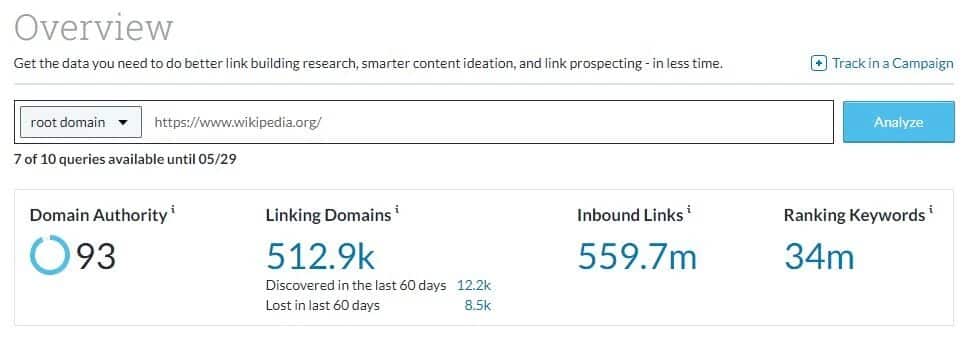
Source: https://blog.hubspot.com/marketing/domain-authority
Understanding these concepts allows you to optimize your webpage to improve its ranking and visibility, ensuring it stands out in the vast sea of online content.
Expertise, Experience, Authoritativeness, and Trustworthiness (E-E-A-T)
The E-E-A-T model represents Expertise, Authority, and Trustworthiness, and it’s a fundamental evaluation guideline used by Google’s Quality Raters to assess content quality. Following the E-E-A-T framework in SEO can significantly improve relevance and authority.
Here’s what E-E-A-T stands for:
- Expertise: The level of knowledge or skill in a particular field reflected in the content.
- Experience: Having first-hand knowledge or engagement with the subject matter.
- Authoritativeness: Being recognized as a source of authority, with other sites linking to yours and vouching for your credibility.
- Trustworthiness: Ensuring your website and its content are credible and current. This can be improved by clearly displaying contact information and using secure HTTP.
It’s worth mentioning that 65% of SEOs reported a positive impact from Google’s 2023 algorithm update, which included an updated E-E-A-T framework. Implementing this framework will improve your overall SEO strategy.
What Is The Algorithm?
Search engines employ complex equations known as search algorithms to analyze vast amounts of information. While search engines guard the secrecy of their algorithms, certain factors that influence page ranking have been identified and are commonly referred to as ranking factors.
Developing an effective SEO strategy requires understanding and optimizing these four crucial ranking factors:
- The meaning behind someone’s query, which is their most likely intent for starting a search, and how that intent matches the most helpful content.
- Relevancy between the search query and the content on a page, and search engines assess it by various factors like topic or keywords.
- Quality of content, which uses the E-E-A-T model to surface content that seems the most helpful based on signals like expertise, authority, and trustworthiness.
- The usability of a site, which considers page speed, mobile friendliness, and other factors related to how easy it is to discover content on a site.
Google, boasting an impressive 92.08% market share in search engines worldwide as of July 2023, is the go-to choice for most consumers. By implementing SEO strategies that align with it, you can direct your marketing strategies to the evolving buying behavior, where 86% of consumers rely on search engines for information.
Additionally, a staggering 67% of B2B buyers initiate the buying process with a web search, underscoring the significance of appearing in search results. With Google’s dominance in the search engine realm, leveraging SEO becomes an indispensable tool for businesses aiming to succeed and engage with their audience.
Knowing the significance of SEO and Google is just the beginning. The real challenge lies in learning how to harness its power and effectively integrate it into your overall marketing strategy. Now, let’s get down to the core of creating a successful SEO plan to help your business achieve online visibility and growth.
Part 3: How To Build A Strong SEO Strategy
If you need help getting traffic to your website despite your marketing efforts, what your website needs is a robust SEO marketing strategy, and a comprehensive plan to attract more visitors to your website. You can optimize your site and improve its ranking by focusing on three key areas – compelling content, technical website setup, and strategic link building.
Content
When you use a search engine, you’re actively seeking content – information to answer a specific question or solve a problem. This content can take various forms: Text, like a blog post or web page, or even a video, product recommendation, or business listing. In short, it’s all about content. And for SEO, it’s the key to gaining better search visibility. Customers crave content when they search. No matter their needs, it’s content that fulfills them. The more content you publish, the greater your chances of being seen in search results.
Additionally, Search engines rely on content to determine how to rank pages. They analyze factors like page length and structure to assess its quality and relevance to a user’s query. Doing so matches the most relevant pages to a user’s search.
Now, let’s discuss the first step in optimizing content: keyword research.
- Keyword Research:
Keyword research is the first step in creating a winning SEO strategy. The objective of keyword research is to identify the search terms your potential customers use to find products or services similar to what you offer. By doing so, you can create content that is relevant to your audience and will rank higher in search engine results. The process of identifying relevant keywords involves identifying key topics most relevant to your website and then conducting extensive research to uncover related terms your audience would use.
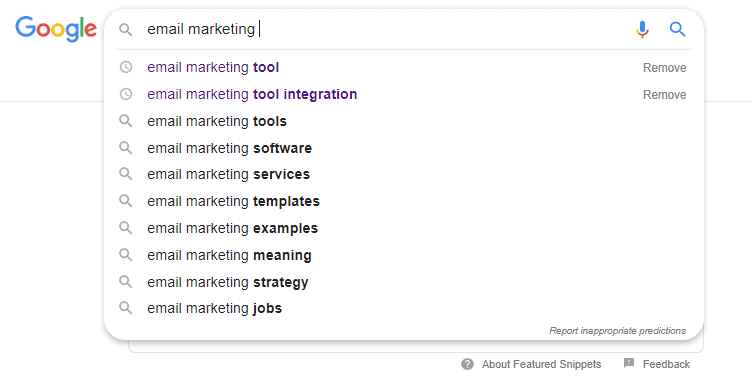

Source: https://sproutsocial.com/insights/how-to-do-keyword-research/
- On-Page Optimization:
On-page optimization is necessary to ensure search engines fully comprehend a page’s topic and keywords, ultimately matching it to relevant searches. This optimization process encompasses more than just the words on your website; it also involves optimizing elements in the code. While you may be familiar with popular meta-tags like the title or description, on-page optimization encompasses various other aspects. These include internal and external links, content length, and multimedia.
By diligently optimizing these on-page elements, you can be confident that search engines will comprehensively understand your website, presenting it to the right audience in search results.
- Keyword On-Page Optimization:
To rank highly on SERPs, web analysts, and SEO experts recommend optimizing your on-page content around target keywords. This is the most effective SEO strategy. To achieve this, make sure to include the main keyword in the following key areas:
- Post’s Title: Ideally, place it as close to the start of the title as possible. Google tends to give more importance to words at the beginning of the headline.
- URL: Your page’s web address should also include the keyword. Ideally, include only the keyword without any other words. Also, remove any stop words.
- H1 Tag: This tag automatically displays the page’s title in most content management systems. However, double-check that your platform doesn’t have a different setting.
- First 100 Words or First Paragraph: To reassure Google that this is the page’s topic, include the keyword at the beginning of your blog post.
- Meta Title and Meta Description Tags: Search engines use these two code elements to display their listings. The meta title appears as the search listing’s title, and the meta description provides content for the little blurb below it. Both elements help search engines understand the page’s topic.
- Image File Names and ALT Tags: Remember, search engines can only see image file names. Therefore, ensure that at least one image contains the keyword in its file name. The ALT tag, displayed by text browsers for visually impaired visitors, is also used as a relevancy signal by search engines.
Also, consider adding semantic keywords, variations or synonyms of your primary keyword. Search engines use semantic keywords to better determine a page’s relevancy.
- Non-Keyword-Related On-Page Optimization:
On-page SEO is not just about randomly scattering keywords throughout the page. There are several factors that not only verify a page’s credibility and authority but also contribute to an excellent user experience:
- External links: By linking to other relevant pages on the same topic, you’re helping Google understand the subject better and ensuring a valuable user experience.
- Internal links: These links serve two critical purposes. First, they help search engines discover and crawl other pages within your website. Second, they establish semantic relationships between different pages, enhancing their relevance to search queries. Aim to include at least 2-4 internal links in every blog post.
- Content length: Quality long-form blog posts typically provide more comprehensive information on a topic, keeping readers engaged for longer. This increased time spent on your site, known as dwell time, is a crucial ranking factor for search engines.
- Multimedia elements: Incorporating multimedia features such as videos, diagrams, and audio players can indicate the quality of a page. Like longer content, multimedia keeps readers on a page for an extended duration, signaling that they find the content valuable and worth exploring.
By following these strategies, you can structure your on-page SEO efforts to foster engagement and deliver a meaningful user experience.
Technical setup
To ensure your website ranks and appears in relevant search queries, it’s crucial for search engines like Google to:
- Quickly discover your web pages on the internet.
- Scan and comprehend the topics and keywords within your pages.
- Add them to their index.
Website owners often assume that their site is accessible not only to them but also to search engines. However, there’s a catch. A webpage may appear differently to you compared to how it appears to a search engine. So, let’s delve into the technical aspects of website optimization that need to be looked into:
- Website navigation and links:
Use text-only formats for site navigation and links for optimal website visibility and comprehensibility by search engines. While search engines crawl websites like humans, they can only process text, rendering images or videos invisible to them. By adopting this approach, you can ensure that your website is effectively indexed and easily discoverable online.
- Simple URL structure:
Keep URLs as simple as possible. Long and complex URLs with unnecessary words or characters can confuse search engines. Set them up to include the primary keyword and other relevant keywords with a few additional words beyond that, if necessary.
- Page Speed:
Google considers load time as a quality indicator while ranking your website. Image size can affect page speed, but services such as Google’s Page Speed Insight Tool can help suggest ways to improve your pages and make them faster.
- Dead links or broken redirects:
Make sure that the website is free of dead links and broken redirects. They can harm the user’s experience on your website and prevent search engines from indexing the page, affecting your site’s visibility.
- Sitemap and Robots.txt files:
A sitemap is a simple file that lists all URLs on your site, making it easy for search engines to identify which pages to crawl and index. A robots.txt file tells search engines what content not to index. Both of these files help speed up crawling and indexing of your website.
- Duplicate content:
Avoid confusing search engines by eliminating identical or similar content across different pages of your website. Instead, focus on diversifying your phrasing or consolidating similar pages. This will help you prevent duplicate content and enhance the overall user experience.
Links
Also known as backlinks, they are valuable references to your content found on other websites. Each time another website mentions and directs its readers to your content, you gain a valuable backlink to your site. This can significantly boost your online presence and increase the visibility of your website – on Google, for example, which uses the quality and quantity of your backlinks as a signal of a website’s authority.

Source: https://www.semrush.com/blog/what-are-backlinks/
Additionally, links from similar topics to yours carry more relevance than those from different domains.
- Types of Links
To build quality links, there are several effective strategies you can use:
- Editorial links: These links naturally come from other websites that find your content valuable.
- Outreach: Reach out to other websites and request them to link to your content.
- Guest posting: Write high-quality content for other websites as a guest author, which will link back to your website.
- Profile links: These are links to your website from online profiles on various websites.
- Competitive analysis: Identify the websites that link to your competitors and replicate their strategies to obtain links from the same sources.
Implementing these strategies can enhance your link-building efforts and establish a solid online presence.
- Link Quality Factors
Regarding links, it’s important to understand that not all are created equal. Some links can potentially harm your website’s authority rather than boost it. To ensure the effectiveness of your links, consider the following key factors that determine their quality:
- Quality of the linking websites: The quality of the websites that link to your site is of utmost importance. Search engines prefer authoritative websites, so strive to obtain links from reputable sources.
- Relevance of the linking websites: Links from websites that share similar topics to yours can have a significant impact on your rankings. Aim for links that are contextually relevant to your content.
- Trustworthiness of the linking domains: Links from trustworthy domains can bolster the credibility of your website. It’s wise to seek links from established and respected sources.
By focusing on these quality factors, you can ensure that your links not only benefit your website but also contribute to its overall success. Remember, it’s not just about the number of links but the quality that truly matters.
Having discussed the importance of link-building and the factors contributing to link quality, let’s explore another powerful SEO tool – keyword research and keyword targeting.
Part 4: How to Conduct Keyword Research and Targeting
Now that we’ve covered the importance of using keywords let’s dive into the details of researching and targeting them.
When it comes to promoting your business or brand through a website, simply creating it isn’t enough. You want it to stand out and appear at the top of search result pages. Here’s where keyword research and targeting come into play.
First, keyword research and targeting involve:
- Discovering the specific words and phrases people use when searching online.
- Selecting the most suitable ones for your website.
- Optimizing your content with these keywords.
Identify Your Goals
Before diving into keyword research, take a moment to identify your goals. Ask yourself what you truly want to achieve with your website and pinpoint the specific type of keywords that will assist you in reaching those goals successfully.
What’s the User’s Intent?
Understanding the user’s intent is essential when conducting keyword research. It helps you determine whether a search term is transactional or informative. You can effectively target specific keywords and create relevant content by identifying the user’s intent.
For example, Imagine someone searching for “luxury flooring” or “luxury tiling.” This transactional search indicates that the user intends to make a purchase. On the other hand, if someone searches for “What’s the best flooring for a home with kids and pets?” it’s an informative search. In this case, the user is looking for information before making a decision.
By determining the user’s intent, you can create engaging content that meets their expectations and provides the information or products they seek.
What’s the Search Volume?
When selecting keywords, consider their search volume. Search volume, which refers to the number of searches for a specific keyword within a given timeframe, can significantly impact your website’s ranking. Here are some key points to keep in mind:
- High-volume keywords are more competitive and can be harder to rank for.
- On the other hand, low-volume keywords are less competitive and easier to rank.
- It’s essential to strike a balance between search volume and competition to find the most effective keywords for your content.
By understanding the relationship between search volume and competition, you can optimize your keyword strategy and enhance your website’s visibility.
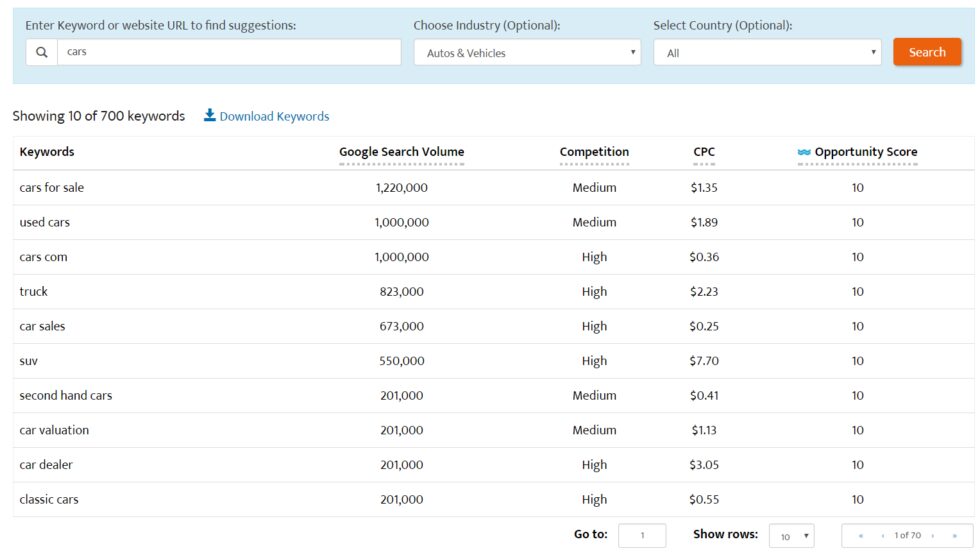
Source: https://www.wordstream.com/keyword-strategy
Consider Your Keyword’s Relevance
To maximize the impact of your content, it’s better to target keywords relevant to your business or brand. By doing so, you align your products or services with the content you create, making it more likely to drive conversions.
For example, consider a blog post on “How to choose the best coffee machines.” By incorporating this keyword, your website will rank high, increasing visibility and potential customers.
Identify Long-Tail Keywords
Long-tail keywords, consisting of three or more words, are becoming increasingly popular in recent years. They allow marketers to target specific customers by addressing their needs directly. Using long-tail keywords also makes it easier to rank in SERPs.
For example, a keyword like “best coffee machines” is too broad and competitive. A long-tail keyword, such as “top-rated automatic espresso machines,” has less competition and higher relevance.
Observe the Competition
To identify the most effective keywords, a great approach is to observe the competition level. Various keyword research tools, like SEMRush, Google Keyword Planner, and Uber Suggest, can help you check the competition level of a particular keyword. These tools provide comprehensive reports on the difficulty of ranking for specific keywords. Using these, you can make informed decisions about your keyword selection and optimize your content for better visibility.
Create Buyer Personas
Another way to optimize your keyword research is to create buyer personas. These personas help you narrow down your target audience and understand the terms they use when searching for products or services related to your business.
For example, if you’re a fitness brand, think about a persona like “Active Amy,” a busy mom looking for workout routines who’d potentially search keywords such as “best workout for busy moms” or “fitness for moms.” By understanding her needs and preferences, you can tailor your keyword strategy to attract and engage customers like her.
Analyze Your Results
Once you’ve completed your research, it’s time to analyze and implement the results in your digital marketing strategy. Remember, keyword research isn’t a one-and-done task; it requires ongoing effort to optimize your website with relevant keywords. Regularly monitor your website’s performance, stay updated with search trends, and adjust your keywords to stay ahead.
Finally, remember to track the performance of your content and adjust your strategy accordingly. Monitor how keywords perform, measure the impact of SEO efforts, and analyze how your pages rank in search engine result pages. By continuously monitoring and optimizing your SEO strategy, you can ensure that your content drives the maximum traffic to your website.
Part 5: Targeted On-Page SEO Optimization
One of the most important things you can do to improve your website’s visibility on search engines is to optimize it for on-page SEO. By strategically aligning your content and structure, you’ll enhance your website’s performance and increase its chances of ranking higher.
Keywords and Content
Start by identifying the keywords you want to rank for. Create a targeted keyword list and incorporate it strategically into your site’s content. Remember, each webpage should focus on one primary keyword and a cluster of related keywords. Remember that your content should also captivate your audience and address their queries. Ensure it is unique, informative, and user-friendly.
For instance, let’s say you want to rank for the keyword “best pizza in town.” Your webpage should provide mouthwatering descriptions of your pizza flavors and include customer reviews, local testimonials, and even a video of your talented chef creating a delightful pizza masterpiece.
Google is placing more emphasis on engagement these days, so your content should be engaging enough to keep your audience on your website, and it should be concise and to the point.
Meta Descriptions and Title Tags
Both meta descriptions and title tags play critical roles in helping search engines understand the content on your webpage.
- Title Tags
- The title tag serves as the headline of your webpage, appearing at the top of the browser. It plays a critical role in helping search engines understand the central theme of your webpage content.
- Remember to incorporate your targeted keywords into the title tag. This not only aids Google in recognizing your page’s relevance to a user’s search query but also improves the chances of your webpage ranking higher.
- Meta Descriptions
- The meta description provides a summary of the content on your webpage. This is typically displayed directly under the title tag in search engine results.
- It is also essential to include your targeted keywords in the meta description. Keep it concise, informative, and enticing to prompt the user to click on your link.
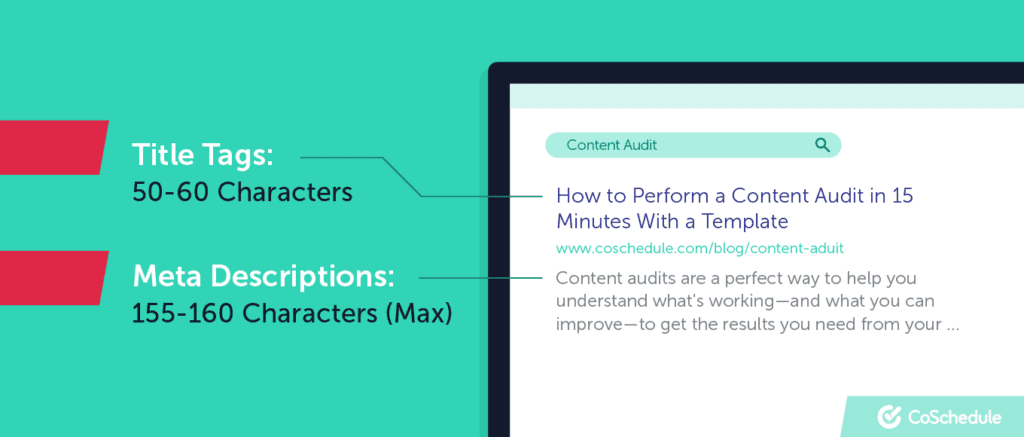
Source: https://coschedule.com/blog/content-audit-template
By doing this, you are helping Google to recognize that your page is relevant to the user’s search query. Be sure to keep both concise and informative to make your audience click on your link.
URL Structure
Your site’s URL structure is vital in optimizing user experience and providing valuable insights to search engines. For this reason, you need to create a user-friendly URL structure, incorporating targeted keywords in both the URL and page content.
Remember not to overload the URL with keywords, however. Instead, aim for a clear, concise, and descriptive URL. Only make changes to your URLs when necessary, and ensure you implement 301 permanent redirects correctly.
Alt Attributes
Your image markup significantly impacts how search engines perceive your page and generate search traffic from image searches. The alt attribute in HTML provides alternative information for images when they cannot be viewed. Considering the potential for image breakdowns or user connectivity issues, having a detailed image description enhances overall usability. This also creates an opportunity to help search engines understand the context of your page beyond its content.
Avoid stuffing your alt attribute with excessive keywords or forced variations. Instead, focus on providing a comprehensive and accurate description of the image, as if you were explaining it to someone unable to see it.
Adopting a natural writing approach and avoiding over-optimization prevents triggering Google’s filters and increases your chances of ranking for valuable long-tail variations related to your topic.
Schema & Markup
Finally, there’s schema markup. Commonly known as “schema,” this powerful tool uses tags or microdata to enhance how search engines interpret and display your web page in SERPs. It’s a collaboration led by Google, Bing, and other search engines to establish a universal code language their crawlers can easily comprehend. Integrating schema markup helps search engines understand the context of your content, resulting in more accurate search listings and potentially higher click-through rates.
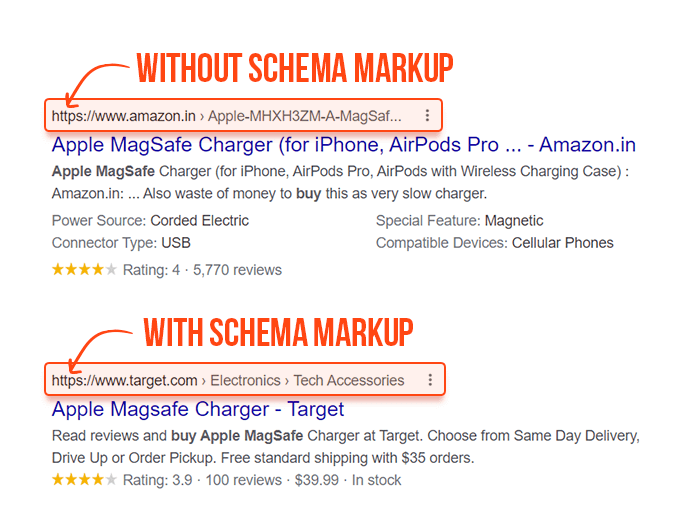
Source: https://www.link-assistant.com/news/structured-data-for-seo.html
To incorporate schema markup into your website, follow these steps:
- Identify the Content to Highlight: Determine which information on your website would benefit most from schema markup, such as product details, reviews, or events.
- Generate Your Schema Markup: Utilize tools like Google’s Structured Data Markup Helper or Schema.org to generate the necessary schema markup. Choose the appropriate schema for your content, fill in the details, and obtain the HTML code.
- Add Schema Markup to Your Website: Incorporate the generated schema markup into your HTML. Ideally, place it in the header or body section.
- Test Your Schema Markup: Use tools like Google’s Structured Data Testing Tool to verify the correct implementation of your schema markup. This tool will identify any errors or provide suggestions.
- Monitor Your Results: Keep track of your website’s performance using Google Search Console. Correctly implemented schema markup should translate into improved search presence over time.
By leveraging schema markup, you provide search engines with valuable insights into your webpage’s content. While schema markup doesn’t directly influence your website’s ranking, it enhances your presence in SERPs by enriching your meta descriptions with additional information, such as ratings, and showcasing rich snippets. When deployed correctly, schema markup helps distinguish your website, leading to higher click-through rates and boosting your website’s ranking.
Now that you have a more precise grasp of technical SEO aspects and on-page SEO optimization to enhance your website’s visibility, let’s shift our focus to another part of SEO: information architecture and internal linking.
Part 6: Information Structuring and Internal Linking for Your Website
Information architecture or information structure refers to how you organize the pages on your website. How you structure and interlink between your pages can significantly impact how your website ranks in response to searches.

Source: Original, based of this https://blog.hubspot.com/website/information-architecture
What is Information Architecture and Internal Linking?
While information architecture refers to how you organize your website content and how your site visitors navigate through it, internal linking establishes connections and interlinks between pages on your website. By strategically structuring your website and creating engaging pathways, you can provide a seamless browsing experience that keeps users returning for more.
The Benefits of Information Architecture and Internal Linking
When correctly designing your website with proper information architecture and internal linking, you can achieve the following benefits:
- Enhanced User Experience: A well-designed website ensures smooth site navigation, making it easy for visitors to find what they want.
- Increased Click-through Rates (CTR): By organizing your content strategically, you can entice users to click on relevant links and explore more of your website.
- Heightened Authority and Search Engine Ranking: A robust website structure showcases your expertise in the industry, leading to improved credibility and higher search engine rankings.
- Expanded Online Presence and Brand Visibility: With a solid information architecture, your website becomes more discoverable, helping you establish a more substantial online presence and increase brand visibility.
Information Architecture and Internal Link Optimization
One way to optimize your website’s information architecture is by planning and organizing your site content based on priority. You can leverage spreadsheet tools or visual website mapping tools like Slickplan to create interactive sitemaps that allow you to arrange your content easily.
Once your content is organized correctly, it’s time to focus on internal linking. Make sure the links within your content are relevant, natural, and valuable to your readers. Striking the right balance is critical here. Including links to important pages and frequently linked-to pages from your homepage can significantly boost your site’s performance.
Remember, internal linking guides users through your website and enhances their overall experience. So, take the time to structure your content effectively and make every click count for your audience.
Best Practices for Effective Site Structure and Internal Linking
When designing the information architecture and internal linking of your site, keep the following tips and best practices in mind:
- Use descriptive and relevant anchor text for your internal links. This will guide your users to the right destinations and improve their overall browsing experience.
- Be mindful of broken links. Double-check and ensure that all your links are functioning correctly. This will prevent any frustration or inconvenience for your visitors.
- Maintain a clear and coherent internal organization and structure for your website. This will help users navigate your site effortlessly and find the information they need.
- Continuously monitor your site’s performance and make necessary adjustments to your strategy. By doing so, you can ensure that your website is running smoothly and meeting your objectives.
By following these guidelines, you’ll be able to create an engaging and well-structured website that provides a seamless user experience to your visitors.
Part 7: Content Marketing and Link Building for Google Search Optimization
To increase your online presence, you must ensure that your website ranks high in Google searches. That’s where content marketing and link-building strategies come into play.
How to Develop Quality Links
To achieve higher rankings in Google, you need to develop quality links. Unfortunately, many websites have resorted to questionable practices – one example being “black hat” SEO link-farming, which can quickly lead to penalties. That’s why focusing on content marketing and link-building strategies that prioritize traditional public relations (PR) and creating helpful content is essential.

Source: https://www.munro.agency/how-to-do-link-building-for-your-business/
One effective approach is to craft engaging blog posts, such as informative how-to guides or thought-provoking opinion pieces. Creating eye-catching infographics and videos can also significantly boost your chances of going viral, especially when accompanied by the right promotional efforts.
Understanding Your Audience
The first step in content marketing and link building is identifying and understanding your linking and sharing audience. You can achieve this by utilizing helpful tools such as BuzzSumo, Ahrefs, and FollowerWonk. These tools will assist you in discovering thought leaders and potential linkers within your niche.
By familiarizing yourself with the people and platforms that hold significance in your industry, you can gain insights into the kind of content they typically share and the challenges they face. With this knowledge, you can craft unique and valuable content that resonates with your audience, thus converting prospects into loyal customers.
Creating and Promoting Content
Creating and promoting content for links and social shares may be labor-intensive, but the rewards are worth the effort. Begin by conducting a comprehensive content audit to understand your capabilities and identify potential content assets others will likely share and promote. As you progress, actively participate in conversations across social media and forums to uncover exciting topics.
It’s important to understand your capabilities and what resonates with your audience. Here’s a strategic approach:
- Identify valuable content: Solve your prospects’ and customers’ problems by listening to social media and forums for blog topic ideas.
- Enhance existing ideas: Reverse engineer successful content and create something even better. This minimizes risk and increases the chances of creating compelling content.
- Showcase others: Highlight valuable tools you use and seek answers from ind
- ustry experts to complex questions. When you feature someone or their product as a valuable resource, they’re more likely to support and promote your content.
- Diversify your content assets: Create various forms of valuable content and develop a promotion strategy for each. Feel free to contact individuals or communities who would benefit from your resources.
Mapping Your Assets to Keywords
The success of your content marketing and link-building strategy also depends on how well you can target relevant keywords. Avoid including keywords that do not fit naturally within your content. When conducting keyword research, always research your audience’s pain points. As you create new content that addresses these needs, explore new ways to include the language used by your prospects and customers. The ultimate objective is to maximize content engagement and sharing, so keep your focus on achieving this goal.
Building a Relationship with Influencers
Lastly, building relationships with influencers in your niche is incredibly beneficial in helping you succeed in your quest for improved Google searches. By creating value for them, providing unique data and knowledge, and consistently being of use to smart content creators, you’ll start to build powerful partnerships that can influence search rankings positively.
Content marketing and link-building strategies to grow your brand online can be incredibly effective. Still, it requires time, effort, and resources.
Considering the importance of content marketing and link-building strategies, spotlighting technical SEO is equally essential.
Part 8: Best Technical SEO Practices to Boost Your Google Ranking
As a digital marketer or small business owner, ensuring your website’s Google ranking is a top priority. While content marketing is crucial, you should address technical SEO issues hindering search engine efficiency in ranking your site. Although technical SEO can challenge larger websites, even smaller to mid-sized businesses can benefit from being aware of common mistakes and issues.
XML Sitemap
Submitting an XML sitemap to Google and Bing is a crucial step to help search engines understand the structure of your website. An XML sitemap is a file that lists all the pages on your site. Ensure you don’t include irrelevant pages such as archives, dropdown pages, etc. By having an XML sitemap, you’ll get your site crawled and indexed faster.
Page Speed
A fast website improves user experience and influences search engine rankings. Use Google Page Speed Insights to measure your website’s speed and get feedback on improving it. Attention to page speed is essential since visitors usually leave web pages that take longer than three seconds to load.
Duplicate Content
Posting duplicate or similar content on multiple pages can damage your website’s ranking. Besides, it may result in penalties from Google. Use tools like Google Search Console under “Search Appearance > HTML Improvements” to identify thin content and make changes accordingly.
Site Redirects
If you change your website’s URLs or rebuild your entire site, make sure to create 301 redirects from old URLs to new URLs. This lets Google and other search engines know your site’s content has been moved. If you don’t implement redirects, you’ll lose valuable traffic and all the hard-earned backlinks that your site has.
Mobile Friendliness
Nowadays, mobile-friendliness plays a critical role in search engine rankings. Ensure your website is fully optimized for mobile users so you don’t miss out on valuable traffic from this vital segment. You can quickly assess your site’s mobile-friendliness using Google’s convenient mobile-friendly test tool.
Header Response
Proper header response codes play a crucial role in technical SEO. Ensuring that functioning pages return the correct code (200) to search engines is important. In contrast, non-functioning pages should return the status code 404 to indicate their absence. Incorrect status codes can mislead Google, making a non-functional page appear functional and potentially causing confusion with thin or duplicated content.
Security
Site security is a significant factor in technical SEO. Maintaining your site regarding plugins and comment spam, and ensuring that your site is served via HTTPS, rather than HTTP, indicates to search engines that your site is secure and trustworthy. Have an SSL certificate to help your site take the necessary steps towards security.
As we’ve said, SEO strategies and research are not a one-time task. It’s an ongoing process that requires constant monitoring and tweaking. Part of that process also requires you to understand how to track and measure SEO results.
Part 9: How to Effectively Track and Measure Your SEO Results
Tracking the impact of your optimization efforts is crucial for the success of your business. With search engines like Google and Bing using algorithms to determine your site’s visibility on SERPs, staying informed is important. By staying on top of your SEO impact, you can adjust your strategies effectively for better results.
Measure Organic Traffic
One way to check your website’s health is to measure organic traffic. You can easily track it through the analytics tool or by following the sessions and looking for the traffic that originates from the search engine.
Organic traffic is highly desirable and sustainable since it’s free, untainted, and independent of external factors. You can use the session filter from Google Analytics to obtain the total number of organic visitors to your site. You can also create custom reports for specific audiences to help you gain more insights.
Check Your Keyword Rankings
Although the reliability of keyword tracking is debatable, keeping an eye on which pages are ranking for your chosen keywords is still recommended. This allows you to track progress as you adjust your strategies. Several third-party tools, such as Ahrefs, SEMRush, and Google Search Console, can help you check your keyword rankings.
Track Your Conversion Rate
Driving traffic to your website is great, but you should also keep track of the conversion rate. Conversion rate means the percentage of website visitors that become customers. The conversion rate could be in the form of newsletter sign-ups, product purchases, etc. By keeping track of this metric and monitoring it, you can adjust your strategies to impact your conversion rate positively.

Source: https://www.sproutmedialab.com/using-analytics-4-for-conversion-rate-optimization/
Monitor Your Backlinks
The backlink profile of your site should be monitored at all times. Backlinks help build the authority of your website and generate traffic. Poor quality backlinks can negatively impact your website’s page ranking. For this reason, you should monitor the backlinks coming to your website, ensuring they are of good quality and help your website stay relevant.
Use Google’s Local Business Listing
Google My Business (GMB) is an excellent tool for monitoring and enhancing your SEO performance. With its help, you can boost your online visibility, making it easier for customers to find your brand on Google search results, Google Maps, and other Google services. This platform is particularly valuable for small local businesses in attracting and connecting with customers effortlessly.
Part 10: Other SEO Considerations: Mobile, International, Local, and App Store
With all of our previous knowledge of technical SEO and how to measure your SEO results in mind, some specific cases and businesses need unique approaches to ranking their websites in different search environments.
Mobile SEO
You need to optimize your website for mobile devices to rank higher in mobile search results. Here are some key strategies:
- Create a responsive website that adjusts to different screen sizes.
- Avoid using intrusive interstitials that disrupt the user experience.
- Optimize your images and use lightweight coding to ensure faster loading times.
- Remember, site speed is a critical factor for mobile rankings.
Remember, mobile devices have surpassed desktop computers as the primary means of internet access, so search engine algorithms prioritize mobile-friendly sites. Implementing these strategies will improve your site’s performance and boost its visibility in mobile search results.
International SEO
International SEO is a powerful approach to boosting your website’s ranking across diverse countries and languages. While several SEO aspects remain unchanged, there are specific considerations you must address to captivate a global audience. Translating your content into different languages is one effective way to optimize your site for global searches.
However, it’s important to note that translation alone won’t solve all your international SEO challenges. Cultural differences, strategic keyword usage, and precise geolocation targeting are vital factors that need careful attention.
Local SEO
Local SEO instead focuses on reaching potential customers in your neighborhood. It’s especially valuable for small businesses and franchises who want to dominate location-based searches.
To optimize for local SEO, you must create a Google My Business account. This allows you to provide accurate and consistent information about your business, including phone number, address, and business hours.
Encouraging online user reviews, especially from happy customers, will boost your local search ranking. By implementing these steps, you can ensure that your business grabs the attention it deserves from local customers.
App Store Optimization
App Store Optimization (ASO) is the process of optimizing your app to rank higher on app store search results pages. By optimizing your app’s title, description, and keywords, as well as perfecting your app’s logo and screenshots, you can make a significant impact on its visibility and download numbers. Additionally, guaranteeing that your app’s code is lightweight and fast-loading is crucial for delivering a seamless user experience.
Part 11: More Insights on How Local SEO Works
With an increasing number of people relying on online searches to find businesses and services, we cannot stress the usefulness of Local SEO techniques enough. Local SEO helps businesses appear more easily in searches for potential customers in their specific area. It leverages proximity to a searcher’s location to rank businesses, which is particularly useful for entrepreneurs and small businesses.
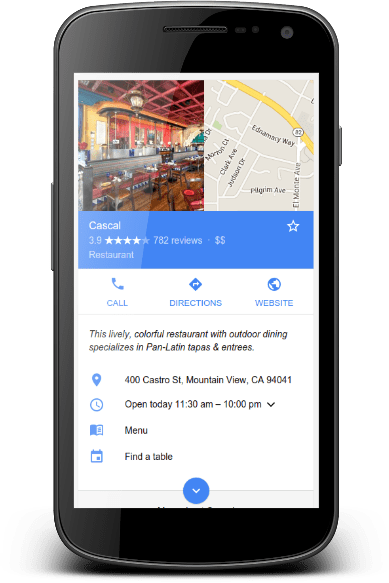
Source: https://www.webcitz.com/blog/how-to-do-schema-for-local-businesses/
Proximity is Key
When it comes to Google algorithms, businesses that are closer to the searcher’s location get priority. This means optimizing your website with your address, phone number, and location will make your business more visible in search results. So, to boost your business’s local SEO, make sure to update your Google My Business (GMB) profile regularly with accurate and up-to-date information.
Keywords and NAPs
Keywords are just as important in local SEO as in global SEO. Boost your website’s rankings by incorporating relevant keywords into your content and meta descriptions. Additionally, please pay close attention to NAPs (Name, Address, and Phone number) optimization, as it is crucial for local searches. To optimize NAPs effectively, follow these steps:
- Keep your NAP up-to-date on your website, online profiles, listings, and directories.
- Ensure consistency in your NAP across different platforms.
- Check for any spelling errors or inconsistencies in your business listings.
Reviews and Citations
User trust in reviews and citations is as strong as trust in personal recommendations from friends and family. That’s why reviews and citations are important in your business’s local SEO. Encourage customers to leave feedback and reviews on your GMB profile, social media, and directory listings. Positive ratings and glowing reviews can boost your business’s search rankings, making it easier for customers to choose you over your competitors.
Google My Business Profile
It may be clear by now, but you’ll definitely want to take advantage of Google My Business. This free tool helps you manage your online presence effectively. Updating your GMB profile with accurate information can significantly increase visibility and improve your ranking.
It’s important to include essential elements in your GMB profile, such as:
- Your business name, address, and phone number (NAP).
- Operating hours.
- Captivating photos.
- Positive reviews, and ratings.
Remember to verify your business, respond to reviews, and regularly update your information to make the most of this tool. Doing so will help you stay on top of search rankings and attract more customers.
Mobile Optimization
Google gives preference to mobile-friendly websites in its search rankings. Ensure your website is responsive, loads fast, and has a user-friendly interface that makes navigation easy. It’s also essential to ensure your website’s content is optimized for local SEO by including your location, NAP, and relevant keywords.
Now that we’ve explained all of the considerations for website SEO and appropriate techniques to improve it, we should also mention what you should not be doing for the good of your website’s and business’ online presence.
Part 12: Black Hat SEO: Why You Should Stay on the Right Side of Search Engine Guidelines
It’s natural to want to grow your brand or business as much as possible, taking shortcuts to achieve these goals or to cut costs. But some techniques are not worth the risk. Under the umbrella term of Black Hat SEO, these practices can harm your brand’s reputation and even lead to penalties from search listings.
Black Hat SEO refers to various tactics to manipulate search engine algorithms for higher rankings in search results. However, these tactics blatantly breach search engine guidelines. Some commonly employed techniques include:
- Keyword stuffing: This involves adding irrelevant keywords to a webpage’s content.
- Cloaking: It conceals keywords in code, making them invisible to users but not to search engines.
- Buying links: Websites resort to purchasing links from low-quality sources to improve their site’s visibility.
Implementing these unethical practices can severely affect a website’s reputation and visibility in search engine results. It’s recommended to instead focus on delivering valuable content that genuinely fulfills users’ needs.
Black Hat SEO techniques may appear enticing at first. Still, they can quickly put your site at risk of being penalized and your reputation damaged. Remember that Google and most search engines constantly update their algorithms to identify and discard websites that employ Black Hat tactics. If your site is flagged, the consequences can be severe – your rankings can plummet, and you might even face a ban from search results.

Source: https://en.wikipedia.org/wiki/Search_engine_optimization
In addition, Black Hat strategies can make your website less user-friendly. Keyword stuffing and cloaking can make your content unreadable and unappealing, causing users to lose interest and quickly move on to another site. And if you’re buying links, those links may not even be relevant to your content, leading to a high bounce rate and low conversion rates.
So why do some people rely on Black Hat SEO techniques? Simply put, it’s because they want faster results. Ethical SEO practices can take time to yield results, and some digital marketers and small businesses are impatient. But taking shortcuts can do more harm than good in the long run. Building a solid online presence takes time, effort, and strategic planning.
Get More Exposure and Traffic For Your Business
SEO is vital for any website to be found and succeed online. With the information provided by this guide, you can drastically improve your website’s visibility and rankings with SEO, content marketing, and link building, giving you an edge over competitors.
Whether you’re looking to grow organic traffic, target new keywords, or build your online presence, having a strong SEO knowledge base is key to driving success on Google. The tips and tactics outlined in this article have proven to work wonders for improving organic performance. Combining these strategies with others, such as tracking metrics and researching different SERPs, ensures you’re making the most of your campaign.
Ultimately, this guide is just the beginning of your SEO journey. Further insights and exploration are essential to unlock the potential for maximum success.
If you need more professional help to improve your website’s overall performance, consider contacting Sprout Media Lab. As a full-service Digital Marketing Agency, we have an experienced Team of Experts ready to create engaging, quality content for your website, Google profiles, and social media, and at the same time, design the best strategy to ensure your website stands out in search results.
Contact us today for a Free 30-minute Consultation or call us now for immediate assistance at (800) 617-6975, and take your first step towards better content marketing!
You can also check out our Small Business Bundled Solutions page.












